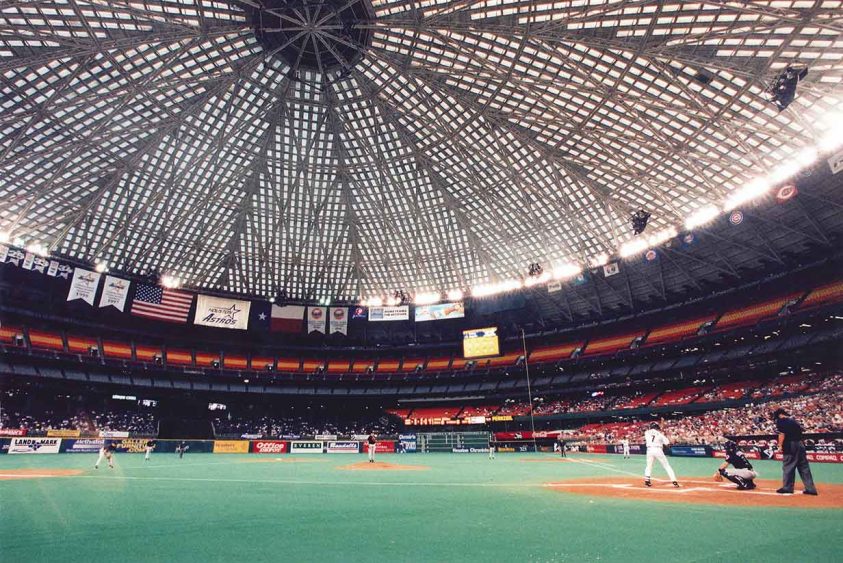
Last week kicked off the NCAA Men’s Basketball Tournament (aka March Madness) that will grip the nation all leading up to the Final Four, hosted this year in Minneapolis. Everyone’s bracket including my own is probably destroyed. The “Final Four” has became such a big event that the usual basketball arenas used by NBA and top-level collegiate teams, with capacities between 17,000 and 22,000 seats, have not been suitable for about twenty years now. Instead domed NFL of over 70,000 seats are filled to max capacity for the event. These venues, specifically those with retractable roofs, have become more popular with cities in recent years.

The first domed stadium was the Astrodome, located in Houston Texas and played host to the Houston Astros and Oilers. Its broke ground in 1965 and was touted a technological marvel. It gave way to the invention of artificial-turf (aka “Astroturf”). Domed stadiums began to become popular, especially in very hot climates (New Orleans and Houston) and very cold climates (Minneapolis and Detroit). Overtime, beginning with the Louisiana Superdome in 1982, these large domed football stadiums became the standard for the Final Four. Such a popular event needs a venue of that size to accommodate the fans.

Eventually technology would create even more incentives for cities to build Final Four worthy venues. Beginning with the opening of the Rogers Center in Toronto in 1989, retractable roofs that can serve as both outdoor and indoor venues have became a favorite of cities desiring the best of both worlds. Beginning in 2007, University of Phoenix Stadium in Glendale Arizona created a roll-able natural grass field so such stadiums can preserve natural grass which is better for players and is required in soccer.

It’s no exaggeration to say that cities have fallen in love with this sort of stadium. Enticed by the idea that hosting events such as the Superbowl, College Football National Championship, Final Four, concerts, high profile soccer matches, and perhaps even a World Cup or Olympics absent of the elements, these venues have multiplied like bunnies. Of the eight NFL stadiums built or that are being built in the past 15 years only one, Levi’s Stadium in Santa Clara, California, is not domed in some way.
/cdn.vox-cdn.com/uploads/chorus_image/image/56280377/999476412.jpg.1504558796.jpg)
What caused this hysteria. One venue in particular set the trend. Since 2009, AT&T Stadium in Arlington, Texas has hosted more sporting events than any other stadium in the world over that period of time. Playing host to the Dallas Cowboys, “Jerry-World” (named after the notorious owner) has brought unprecedented revenue to the city of Arlington and many cities wish to emulate their success. AT&T Stadium is a state-of-the-art venue that has hosted every major sporting event in the US and will even play host to the 2026 World Cup Final. However Dallas Fort Worth is unique amongst US cities. Being the fifth largest media market in the US and centrally located, Dallas’s brand (which is heavily tied in with the Cowboys) is able to attract the kind of high-profile sporting events that many other cities cannot. For example, while it is easy to attract Florida State to play Auburn in Arlington, getting those two schools to play in Phoenix or Minneapolis. While Mercedes Benz Stadium in Atlanta is trying to host a game between Penn State and LSU, the talks seem to remain dormant. Love them or hate them, no team/stadium has the brand of “America’s Team” which allows Arlington to make so much money off America’s team.

The reality for cities is that while re-tractable roof stadiums are great for high profile events such as March Madness, maybe there really can be too much of a good thing. Public money should go towards more important ventures such as education and infrastructure and save the sporting industry to the private sector.

Its pretty cool to see the architectural advancements we have made since the first dome stadium was built in the sixties. I do agree with you that these stadiums should be privately funded.
This blog post was really interesting. Dome stadiums have become more popular in recent years. You do see an increase in that style because of the variety of events you can host there. This can have its pros and cons to the cities that have them. A pro is that the city is receiving more money and gaining more tourists but a con is the money could certainly go elsewhere. This is something the city would have to figure out.
As UNC defeated by Auburn, my year of college basketball has officially announced over. It is pretty messed up with such an upset, but that’s why we love march. Your blog mentioning the arenas for March Madness is very informative. I was shocked two years ago when I saw how huge the final four venue was in Phoenix, Arizona. Indeed, event like this which takes place in huge arena can absorb fair amount of revenue. But the governors do need to pay more attention on affairs like education and city infrastructures.
I really liked this blog! I thought it gave good insight to the use of the domes, especially adding the touch of march madness. Even though locations like these can bring in large revenue, people need to prioritize spending and see if something like that is really what we need at the time.